Abstract
Acid soils with pH values below 5.5 have a negative effect on agricultural production. For this reason, liming is applied as a measure to raise the soil pH to the optimum (pH = 6–7). The aim of our research was to evaluate and compare the effectiveness of four liming materials (wood ash from biomass powerplant, filter dust from cement factory, blast furnace slag from iron factory, and carbocalk (limestone, a by-product from a sugar factory)) in combination with and without solid digestate (a by-product from biogas plant) as organic fertilizer. Two field trials were set up to determine the effect of the studied materials to neutralize the acidity, and the impact on soil fertility and nutrient status in the soil. The results showed that all four liming materials raised the pH of the soil. Out of these four, wood ash showed to be the best while blast furnace slag was the worst. The yield of alfalfa increased with the application of all four lime materials. Application of liming materials with solid digestate increased soil organic matter and had slightly higher yields compared to liming materials without solid digestate. The highest yields were achieved with the application of wood ash, probably due to somewhat higher concentrations of potassium and phosphorus in wood ash. Further research on the financial aspects of investigated by-products application is necessary to exploit their potential as a liming material.
1. Introduction
Soil pH is one of the key factors controlling the plant species distribution, composition, and yields. Acidic soils with pH values below 5.5 create unfavorable conditions for plant growth which in agriculture results in lower crop yields on such fields [1,2]. However, around 30% of the world’s ice-free land area is affected by acidity [3]. Soil acidification is caused by a combination of natural and anthropogenic processes. To increase crop yields in agriculture it is necessary to improve soil conditions, i.e., raise the soil pH level by applying liming materials. However, increasing soil pH creates favorable conditions for micro-organisms growth and increased mineralization which results in loss of labile soil organic matter [4].
The most commonly used liming materials are ground limestones. However due to the deficiency of limestones in some regions, or high costs of transport and use in agriculture, it has become common to use industrial by-products as liming material [5,6,7,8,9]. The use of such materials can be economic as well as environmentally friendly disposal of by-products. In comparison to limestones, industrial by-products greatly differ in chemical and physical properties which are based on the processes and materials they are made from [10,11]. The efficiency of a particular material to increase soil pH and neutralize excessive acidity is represented by effective neutralizing value (ENV). The ENV is the amount of acidity that a liming material will neutralize and it is expressed in comparison with pure CaO as CaO equivalent. The ENV or effective CaO equivalent (NVCaO) in Europe is determined by the titrimetric method [12]. Such determination of neutralizing value has been developed for ground limestones however it has been shown to be a good representation of the ENV for by-products as well [9]. Studies investigating liming materials have shown that the ENV depends both on the chemical composition of the material and the particle size [13,14].
There have been numerous by-products investigated so far. Most of the research is on blast furnace slag from iron or steel factories [5,6,7,9,15,16], probably as it is a by-product for which there is a need to be deposited in an environmentally friendly way. It is a calcium silicate slag that has shown to be as effective as limestones in neutralizing acidity [5,6,7,9,15,16]. However, slag effectiveness depends on its particle size. Slag from steel and iron factory often has coarse particles and it needs to be additionally ground and sieved into smaller particles to spread uniformly and to increase its effectiveness in neutralizing soil acidity [6]. Other by-products include ashes from various industries, such as waste ash from municipal solid waste incineration [17], cyclonic ash (a coal combustion by-product) [16,18,19], and wood ash [7,11]. The increasing number of biomass power plants creates possibilities for the use of wood ash in agriculture. Other studied by-products are cement filter dust [5], papermill by-product [9], and slag from the phosphorus fertilizer industry [9]. Limestone from sugar factories is a common liming material used in agriculture, however due to other growing industries, other by-products may be more interesting, such as wood ash from biomass power plants.
Another usage of by-products can be for fertilization. One such by-product is digestate from biogas plants that is used as organic fertilizer [20,21]. A combination of by-products used for liming with organic fertilizer by-products could result in increasing soil pH and less stress on soil biological process. The aim of the present research is to investigate and compare the effect of using these by-products from industry as liming materials: (a) wood ash (biomass power plant), (b) filter dust (cement factory by-product), and (c) blast furnace slag (iron and steel making industry). More specific objectives are to observe their influence on (a) soil pH and soil organic matter (SOM) when applied with or without organic fertilizer (solid digestate from biogas plant), (b) alfalfa yield, and (c) uptake of some micro and macronutrients, as well as Cd as a toxic element. The environmental and management viability of observed materials is compared to carbocalk, a limestone material from sugar factories which is already available in the Croatian market and widely used.
2. Materials and Methods
2.1. Field Trial
The research was conducted during 2016−2018 on two sites with low soil pH in eastern Croatia (Beljevine 45°33′17.47″ N, 17°59′44.86″ E and Zgone 45°32′33.04″ N, 17°59′33.37″ E). The field trial consisted of investigating four industrial by-products as liming materials: carbocalk (lime from a sugar factory), filter dust (a by-product from a cement factory), wood ash (a by-product from a biomass powerplant), and blast furnace slag (a by-product from an iron factory). In addition, at each site, the field trial was divided into two sides, with and without organic fertilizer, specifically solid digestate, a by-product from a biogas plant (20 t/ha). Additionally, each liming material was applied in two dosages (full dose and half a dose). Therefore, all together we had 18 treatments; 9 treatments with solid digestate and 9 without (Figure 1). These 9 treatments included control and each of four liming materials in two dosages. The amount of each liming material applied was determined based on the initial acidity and target acidity of the soil and the neutralization value of the material determined by titration [12]. The experimental plot of 40 m2 was divided into two parts, where after the determined neutralization value of each liming material, a full dose of each material was applied to one part of the parcel (20 m2) while half a dose was applied to the other half of the parcel (20 m2). The effect of wood ash, filter dust, and slag was compared with the effect of carbocalk (a by-product from a sugar factory, commonly used in Croatia for liming [8]), and a control plot without any liming material.
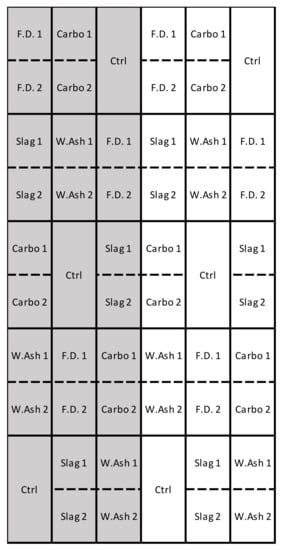
Figure 1.
Field trial scheme. Shaded plots—digestate treatment, non-shaded plots—no digestate treatment. Ctrl—control (no lime applied); CARBO 1—carbocalk, half a dose; CARBO 2—carbocalk, full dose; FD1—filter dust, half a dose; FD2—filter dust, full dose; SLAG 1— blast furnace slag, half a dose; SLAG 2—blast furnace slag, full dose; W. ASH 1—wood ash, half a dose; W. ASH 2—wood ash, full dose.
Alfalfa was planted as a test crop. During two years of observation there were four cuts. However, in the first cut, site “Zgone” had a large weed problem on part of the trial without digestate which resulted in no data on yields of alfalfa on the side without digestate in the first cut for the site “Zgone”. Therefore, at the site “Zgone”, for each treatment, the first cut was 3 samples; the second cut was 6 samples; the third cut was 6 samples; and the fourth cut was 6 samples (altogether, 21 plant samples). At site “Beljevine” we had only three cuts but no weed issues in the first cut. Therefore, at site “Beljevine” the first cut was 6 samples; the second cut was 6 samples; and the third cut was 6 samples (altogether, 18 plant samples). Both sites had 39 samples throughout the 2-year observation for each liming material.
2.2. Soil Properties
Before setting up the experiment, the main soil properties of each site were determined at a depth of 0–30 cm (arable layer): soil pH [22], soil organic matter (SOM) content [23], available phosphorous (AL-P2O5) and potassium (AL-K2O) [24], micronutrients (Fe, Mn, Zn), Cd as a toxic element [25], and hydrolytic acidity (HA) [26], which refers to the total acidity and is an additional property necessary to determine the need for lime application. The soil of both sites is Stagnosol (WRB). The soil was sampled after each cut, and the sample consisted of several subsamples totaling 500 g. For each cut, the same soil properties were analyzed as described earlier.
2.3. Plant Material Analysis
Alfalfa (Medicago sativa L.) was sown as a test crop, a plant species that does not tolerate acidic soils and thus represents an ideal indicator of the effectiveness of applied lime materials [1]. Plant samples were collected at four cuts of alfalfa (Medicago sativa L.) which was sown in April 2016; the first cut was in June 2016 and the last one was in October 2018. After each cut, the biomass yield of alfalfa was determined as well as the mineral composition of the alfalfa. The yield was determined based on sampling plots of an area of ½ m2. The mass of the samples was determined in a fresh and dry state, while the dry matter content was calculated after drying the samples at a temperature of 105 °C to constant weight and expressed in t/ha. In addition, plant material was analyzed for the mineral composition of P, K, Cd, and Zn by ISO standard [25]. Concentrations of essential nutrients (K, P, Zn) and toxic trace elements (Cd) were determined by direct measurement on ICP-OES.
2.4. Analysis of Liming Materials and Digestate
According to the ISO standards, the chemical composition of liming materials and digestate (macro and microelements and potentially toxic trace elements) [26], neutralization value (NVCaO) [12], and pesticide residues in wood ash were determined analytically [27]. Effective neutralizing value (ENV) or effective CaO equivalent (NVCaO) of each liming material was determined by the titrimetric method [12]. The amount of lime applied in the field trial was the amount needed to change the initial soil pH to neutral pH (7). Analysis of digestate included determining dry matter and density [28], organic matter [29], total nitrogen [30], and mineral composition of P, K, Cd, and Zn [26].
2.5. Statistical Analysis
The statistical analysis of the results was performed using Minitab software package version 17 [31]. Analysis of variance (ANOVA) and Tukey’s mean comparison were used to determine the statistical significance at p < 0.05 for all studied parameters.
3. Results and Discussion
Initial soil analysis of the two sites showed low soil pH values, indicating acidic soils and high hydrolytic acidity values and highlighting the need for lime application [32]. The Beljevine site had sufficient soil-available phosphorous, potassium, and SOM while the Zgone site had slightly lower pH compared to Beljevine, as well as somewhat lower SOM and soil-available potassium values (Table 1).

Table 1.
Soil properties.
3.1. Analysis of By-Products
Analysis of lime materials has shown the highest neutralizing value of filter dust from cement factory and the lowest from carbocalk, which is most commonly used in Croatia (Table 2). Blast furnace slag had coarse particle size and had to be additionally sieved. None of the investigated materials had high values of toxic trace elements. Cadmium values in wood ash were slightly higher but still below the MPC prescribed by Croatian regulations for soil improvements in the agricultural soils (5 mg/kg), as prescribed by the Croatian government in the Official Gazette [33]. Furthermore, wood ash had higher values of phosphorous (13.8 g/kg) and potassium (71.1 g/kg) which had an additional beneficial effect on the soil (Table 2). Based on the NV the amount of each material required for the initial soil pH to change to the optimum soil pH was determined. However, since large amounts of each material were needed and such material does not have to be applied at once [2,8], we tested two scenarios: a) application of required full dose and b) application of half a dose of each material (Table 3).

Table 2.
Properties of liming materials and digestate. Values are presented as mean values.

Table 3.
Amount of liming material applied.
3.2. Effect on Soil Properties
Wood ash and filter dust were equally successful in neutralizing the excess acidity just as well as the carbocalk from the sugar factory. The blast furnace slag also raised the pH value in comparison to the control. However, this increase in pH was significantly lower compared to the other three liming materials (Table 4). The results also indicate that even half a required dose is enough to increase the soil pH to a favorable level. As many authors report, often there are no significant differences in plant growth due to different dosages as the positive effect of liming is also influenced by genotype, soil type, and weather conditions [2,34,35]. Therefore, gradually adding lime materials over several years produces positive results while causing less stress to the soil.

Table 4.
Effect of different lime materials on soil pH.
With time, the soil pH has started to decrease again (Table 5). Many authors report the long-term benefit of lime application. Antunović et al. [8] show that 13 years after carbocalk application (15 t/ha) the soil pH is still high (pH above 6). Therefore, we expect that the high pH will remain for some time although it is showing a slight decrease. The effect of digestate on pH was not observed, i.e., there were no differences in pH levels at each cut between treatment with digestate and without.

Table 5.
Soil pH during two-year observation after lime application (four cuts).
Application of digestate increased SOM concentration (Table 6). However, observation of SOM during two years indicates a decrease in SOM (Figure 2). The application of liming materials increased the pH and created a favorable condition for microorganism growth which can lead to the faster decomposition of SOM [4,36]. Liming increases soil microbial biomass, soil respiration rate, microbial respiration, soil enzyme activity (dehydrogenase, sulphatase, and protease activity), and net mineralization of soil organic N and S [4]. We suspect that increased microorganism activity led to the decrease in SOM.

Table 6.
Effect of application of digestate on soil organic matter (SOM).
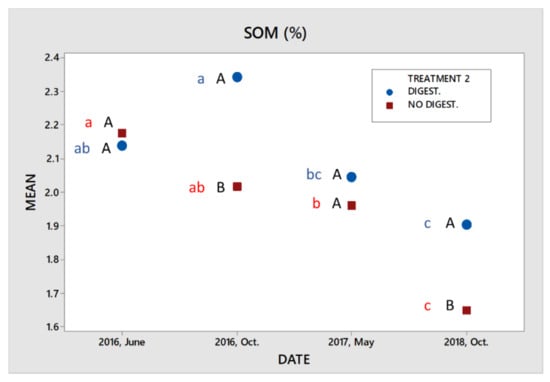
Figure 2.
Effect of application of digestate on soil organic matter (SOM) through four cuts. Different BLUE letters indicate statistically. Significant differences in digestate treatment through two years of observation. Different RED letters indicate statistically significant differences in no-digestate treatment through two years of observation. Different BLACK letters indicate statistically significant differences between digestate and no digestate at each cut.
The effect on soil nutrients was observed with the application of wood ash that had higher concentrations of phosphorous and potassium compared to other liming materials (Figure 3a,b). Ash usually contains around 1% of P and between 4–10% of K, and it is used in fertilization [11,37,38]. In our investigation, ash also had Cd concentrations near the maximum permissible concentrations; however, the results showed no significant increase of Cd concentrations in soil by applying ash.
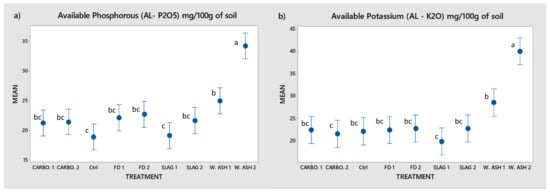
Figure 3.
(a) Available soil phosphorous and (b) available soil potassium.
3.3. Effect on Alfalfa Yield
Application of all of the observed liming materials resulted in higher yields of alfalfa compared to the control (Table 7, Figure 4a). Higher yields were also achieved due to the application of digestate which is clearly seen on control plots with and without digestate (Table 7). Although none of the liming materials resulted in significantly higher yields from the control, it is evident, especially from treatment without digestate, that applying liming materials can double the yields (Table 7, Figure 4a). The application of lime affects the acquisition of both water and mineral nutrients through chemical, physical, and biological effects on the soil. It influences the chemical forms of mineral nutrients that a plant can take up, reduces available concentrations of toxic elements such as Al3+, alleviates Ca and Mg deficiencies in crops, and affects soil bulk density, soil strength, and the architecture of pore systems, as well as biological activities in the soil [35]. Creating such favorable conditions for the uptake of essential elements results in higher crop yields [1,2,8,34]. Our results indicate the highest yields by the application of wood ash (Figure 4a) which had the steepest increase during the observed two years (Figure 4b). These higher yields were probably due to the high nutrition value of ash (71.1 mg/kg K and 13.8 mg/kg P) and high dosages applied.

Table 7.
Effect of application of different liming materials on alfalfa yield.
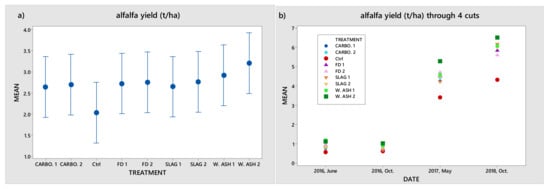
Figure 4.
(a) Alfalfa yield under the studied treatments and (b) alfalfa yield through four cuts.
3.4. Effect on Plant Nutrition
An increase in soil pH decreases the availability of cations [39], however, we did not observe a decrease in uptake of essential elements (Mn, Fe, P). There was only a decrease in Zn and Cd uptake compared to the control treatment (Figure 5b and Figure 6b). Furthermore, we observed a significant increase in potassium uptake in treatment with wood ash compared to carbocalk treatment (Figure 7). However, this increase was not due to the liming effect but due to the significantly higher concentrations of potassium in wood ash. However, some authors report an increase in potassium uptake in alfalfa due to the lime application [1].
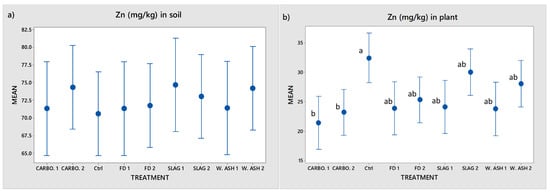
Figure 5.
(a) Zinc (Zn) in soil and (b) zinc (Zn) in plant.
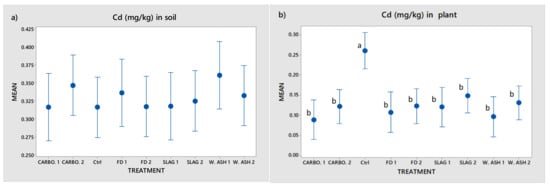
Figure 6.
(a) Cadmium (Cd) in soil and (b) cadmium (Cd) in plant.
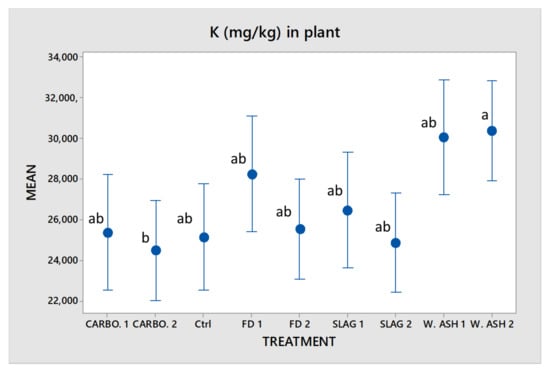
Figure 7.
Potassium (K) in plant. Different letters indicate statistically significant differences among treatments.
Cadmium is considered a toxic element with high solubility in water and increasing availability in soil with low pH [39]. In our field trial, Cd was low in concentration, however Cd uptake is highly susceptible to changes in the soil. For this reason, increasing soil pH close to neutral by liming can contribute to a decrease of Cd uptake by crops and minimize contamination of food by Cd [40,41]. Applying all four investigated liming materials resulted in immobilization of Cd and also significantly lower Cd uptake compared to the control (Figure 6b). Although ash showed no significant increase of Cd concentration in soil, the frequency of ash application needs to be controlled to avoid potential Cd accumulation.
3.5. Management of Lime Application
When using limestone as a liming material we only affected the pH change; however, when using various by-products, different nutrients were added as well. Therefore, when limestone is lacking, other by-products can efficiently replace it. There are three key factors influencing lime management: liming material type, liming application method, and soil properties and their influence on liming management [38]. Our results indicate wood ash and filter dust have the greatest benefits when observing soil pH increase and alfalfa yields. From an economic point of view, one of the bigger costs in the application of liming materials is the transportation to the fields [42]. With a growing number of small biomass power plants, there is an opportunity for wood ash to become more attractive as liming material, as with more powerplants there is less distance from the factory to the field. However, wood ash, as well as filter dust, have very fine particles which makes its application very difficult. Its application can be very uneven depending on the wind, while the same time, it can cause a lot of problems for the machinery that is used in its application. Further research on how to granulate these materials and make them easier to disperse and transport with less damage to the machinery is necessary for a more detailed economic analysis.
4. Conclusions
All of the investigated liming materials significantly increased soil pH levels compared to the control and showed higher yields of alfalfa compared to the control. Adding solid digestate, a by-product from the biogas plant, as organic fertilizer and combining it with liming materials did not have a significant impact on soil pH or yields of alfalfa compared to the treatments of liming materials without digestate. However, it did show a significant effect on increasing or maintaining higher levels of organic matter. Applying digestate together with liming materials reduced the decomposition of soil organic matter caused by the application of liming materials. Additionally, it resulted in slightly higher yields when compared with treatments without solid digestate. Increasing pH also resulted in reduced uptake of Cd indicating the beneficial effect of liming on uptake of Cd as the toxic element. From the environmental and economic standpoint, filter dust and ash have the potential to be used as a liming material in the area near the biomass and cement factories, as one of the bigger costs in the application of lime is the transportation of liming materials to the fields. An additional advantage of wood ash is its nutritional value which can further reduce the need for fertilization. Filter dust and ash are certainly recommended as liming materials with regular monitoring of soil conditions.
Author Contributions
Conceptualization, K.K. and T.T.; methodology, K.K., Z.L., M.E. and V.I.; formal analysis and investigation, V.I., V.Z. and B.P.; resources, K.K. and V.I.; data curation, V.I.; writing—original draft preparation, V.I.; writing—review and editing, V.I.; visualization, V.I.; supervision, B.P. and Z.L.; project administration, V.I. and K.K.; funding acquisition, K.K. All authors have read and agreed to the published version of the manuscript.
Funding
This research was funded by the Ministry of Agriculture project: “Determining the effectiveness of industrial by-products as new liming materials ”, 2015–2017.
Institutional Review Board Statement
Not applicable.
Informed Consent Statement
Not applicable.
Data Availability Statement
The data is available in the manuscript.
Acknowledgments
The authors would like to thank the Croatian Ministry of the Agriculture for financing the project as well as the Faculty of Agribiotechnical Sciences Osijek who made this research possible.
Conflicts of Interest
The authors declare no conflict of interest.
References
- Peters, J.B.; Kelling, K.A.; Speth, P.E.; Offer, S.M. Alfalfa Yield and Nutrient Uptake as Affected by pH and Applied K. Commun. Soil Sci. Plant Anal. 2005, 36, 583–596. [Google Scholar] [CrossRef]
- Kovačević, V.; Rastija, M.; Iljkić, D.; Brkić, I.; Kovačević, J. Maize and barley response to fertdolomite liming. Poljoprivreda 2015, 21, 30–35. [Google Scholar] [CrossRef]
- Sumner, M.E.; Noble, A.D. Soil acidification: The world story. In Handbook of Soil Acidity; Rengel, Z., Ed.; CRC Press: Boca Raton, FL, USA, 2003; pp. 2–4. [Google Scholar]
- Haynes, R.J.; Naidu, R. Influence of lime, fertilizer and manure applications on soil organic matter content and soil physical conditions: A review. Nutr. Cycl. Agroecosyst. 1998, 51, 123–137. [Google Scholar] [CrossRef]
- Oguntoyinbo, F.I.; Aduayi, E.A.; Sobulo, R.A. Effectiveness of some local liming materials in Nigeria as Ameliorants of soil acidity. J. Plant. Nutr. 1996, 19, 999–1016. [Google Scholar] [CrossRef]
- Munn, D.A. Steel Industry Slags Compared with Calcium Carbonate in Neutralizing Acid Mine Soil. Ohio J. Sci. 2005, 105, 79–87. [Google Scholar]
- Yusiharni, B.E.; Ziadi, A.H.; Gilkes, R.J. A laboratory and glasshouse evaluation of chicken litter ash, wood ash, and iron smelting slag as liming agents and P fertilisers. Aust. J. Soil Res. 2007, 45, 374–389. [Google Scholar] [CrossRef]
- Antunović, M.; Kovačević, V.; Varga, I. Subsequent effects of liming with carbocalk on maize grain yields. Poljoprivreda 2014, 20, 12–18. [Google Scholar]
- Yang, R.; Mitchell, C.C.; Howe, J.A. Relative Neutralizing Value as an Indicator of Actual Liming Ability of Limestone and Byproduct Materials. Commun. Soil Sci. Plant Anal. 2018, 49, 1144–1156. [Google Scholar] [CrossRef]
- Chávez-Guerrero, L.; Flores, J.; Kharissov, B.I. Recycling of ash from mezcal industry: A renewable source of lime. Chemosphere 2010, 81, 633–638. [Google Scholar] [CrossRef]
- Park, N.D.; Rutherford, P.M.; Thring, R.W.; Helle, S.S. Wood pellet fly ash and bottom ash as an effective liming agent and nutrient source for rye grass (Lolium perenne L.) and oats (Avena sativa). Chemosphere 2012, 86, 427–432. [Google Scholar] [CrossRef]
- HRN EN 12945:2008. Liming Materials—Determination of Neutralizing Value—Titrimetric Methods; Croatian Standards Institute: Zagreb, Croatia, 2008. [Google Scholar]
- Álvarez, E.; Viadé, A.; Fernández-Marcos, M. Effect of liming with different sized limestone on the forms of aluminium in a Galician soil (NW Spain). Geoderma 2009, 152, 1–8. [Google Scholar] [CrossRef]
- Vance, W.H.; McKenzie, B.; Tisdall, J. The stability of soils used for cropping in northern Victoria and southern New South Wales. Soil Res. 2002, 40, 615–624. [Google Scholar] [CrossRef]
- Levonmaki, M.; Hartikainen, H. Efficiency of liming in controlling the mobility of lead in shooting range soils as assessed by different experimental approaches. Sci. Total Environ. 2007, 388, 1–7. [Google Scholar] [CrossRef] [PubMed]
- Ruttens, A.; Adriaensen, K.; Meers, E.; De Vocht, A.; Geebelen, W.; Carleer, R.; Mench, M.; Vangronsveld, J. Long-term sustainability of metal immobilization by soil amendments: Cyclonic ashes versus lime addition. Environ. Pollut. 2010, 158, 1428–1434. [Google Scholar] [CrossRef]
- Zhang, F.-S.; Yamasaki, S.; Nanzyo, M. Waste ashes for use in agricultural production: I. Liming effect, contents of plant nutrients and chemical characteristics of some metals. Sci. Total Environ. 2002, 284, 215–225. [Google Scholar] [CrossRef]
- McCarty, G.W.; Siddaramappa, R.; Wright, R.J.; Codling, E.E.; Gao, G. Evaluation of coal combustion byproducts as soil liming materials: Their influence on soil pH and enzyme activities. Biol. Fertil. Soils 1994, 17, 167–172. [Google Scholar]
- Geebelen, W.; Sappin-Didier, V.; Ruttens, A.; Carleer, R.; Yperman, J.; Bongué-Boma, K.; Mench, M.; van der Lelie, N.; Vangronsveld, J. Evaluation of cyclonic ash, commercial Na-silicates, lime and phosphoric acid for metal immobilisation purposes in contaminated soils in Flanders (Belgium). Environ. Pollut. 2006, 144, 32–39. [Google Scholar] [CrossRef]
- Prask, H.; Szlachta, J.; Fugol, M.; Kordas, L.; Lejman, A.; Tużnik, F.; Tużnik, F. Sustainability Biogas Production from Ensiled Plants Consisting of the Transformation of the Digestate into a Valuable Organic-Mineral Granular Fertilizer. Sustainability 2018, 10, 585. [Google Scholar] [CrossRef] [Green Version]
- Baştabak, B.; Koçar, G. A review of the biogas digestate in agricultural framework. J. Mater. Cycles Waste Manag. 2020, 22, 1318–1327. [Google Scholar] [CrossRef]
- ISO 10390. Soil Quality—Determination of pH; International Organization for Standardization: Geneva, Switzerland, 2005. [Google Scholar]
- ISO 14235. Soil Quality—Determination of Organic Carbon by Sulfochromic Oxidation; International Organization for Standardization: Geneva, Switzerland, 1998. [Google Scholar]
- Egner, H.; Riehm, H.; Domingo, W.R. Untersuchung über die chemische Bodenanalyse als Grundlage für die Beurteilung des Nahrstoffzustandes der Boden II. Chem. Extr. zu Phosphor-und Kaliumbestimmung. K. Lantbr. Hogsk. Annlr. 1960, 26, 199–215. [Google Scholar]
- HRN ISO 11466:2004. Soil Quality—Extraction of Trace Elements Soluble in Aqua Regia; Croatian Standards Institute: Zagreb, Croatia, 2004. [Google Scholar]
- Kappen, H. Die Bodenazidität; Springer: Berlin, Germany, 1929. [Google Scholar]
- HRN EN 15662-2018. Foods of Plant Origin—Multimethod for the Determination of Pesticide Residues Using GC-and LC-Based Analysis following Acetonitrile Extraction/Partitioning and Clean-up by Dispersive SPE—Modular QuEChERS-Method; Croatian Standards Institute: Zagreb, Croatia, 2018. [Google Scholar]
- HRN EN 13040:2008. Soil Improvers and Growing Media—Sample Preparation for Chemical and Physical Tests, Determination of Dry Matter Content, Moisture Content and Laboratory Compacted Bulk Density; Croatian Standards Institute: Zagreb, Croatia, 2008. [Google Scholar]
- HRN EN 13039:2012. Soil Improvers and Growing Media—Determination of Organic Matter Content and Ash; Croatian Standards Institute: Zagreb, Croatia, 2012. [Google Scholar]
- HRN EN 13654-1:2005. Soil Improvers and Growing Media—Determination of Nitrogen—Part 1: Modified Kjeldahl Method; Croatian Standards Institute: Zagreb, Croatia, 2005. [Google Scholar]
- Minitab Statistical Software; Minitab Inc.: State College, PA, USA, 2007; Available online: www.minitab.com (accessed on 20 May 2021).
- Lončarić, Z. Soil acidity and lime requirement. In Kalcizacija Tala u Pograničnome Području/Lime Application in Border Area; Lončarić, Z., Ed.; Faculty of Agrobiotechnical Sciences in Osijek, University of Josip Juraj Strossmayer in Osijek: Osijek, Croatia, 2015; pp. 18–27. [Google Scholar]
- Official Gazette. Regulation on Protection of Agricultural Land in Croatia; No. 15/92; Government of the Republic of Croatia: Zagreb, Croatia, 1992.
- Kovačević, V.; Rastija, M. Impacts of liming by dolomite on the maize and barley grain yields. Poljoprivreda 2010, 16, 3–8. [Google Scholar]
- Holland, J.E.; Bennett, A.E.; Newton, A.C.; White, P.J.; McKenzie, B.M.; George, T.S.; Pakeman, R.J.; Bailey, J.S.; Fornara, D.A.; Hayes, R.C. Liming impacts on soils, crops and biodiversity in the UK: A review. Sci. Total Environ. 2018, 610–611, 316–332. [Google Scholar] [CrossRef] [PubMed]
- Chan, K.Y.; Heenan, D.P. Lime affected structural stability of red earth under different tillage, stubble and rotation management. In Proceedings of the Australia and New Zealand National Soils Conference, Adelaide, Australia, 18–20 November 1996; Volume 3, pp. 39–40. [Google Scholar]
- Saarsalmi, A.; Mälkönen, E.; Piirainen, S. Effects of wood ash fertilization on forest soil chemical properties. Silva. Fennica 2001, 35, 355–368. [Google Scholar] [CrossRef] [Green Version]
- Hytönen, J.; Hökkä, H. Comparison of granulated and loose ash in fertilisation of Scots pine on peatland. Silva. Fennica 2020, 54, 1–13. [Google Scholar] [CrossRef] [Green Version]
- Ivezić, V.; Singh, B.R.; Almas, A.R.; Lončarić, Z. Water extractable concentrations of Fe, Mn, Ni, Co, Mo, Pb and Cd under different land uses of Danube basin in Croatia. Acta Agric. Scand B Soil Plant. Sci. 2011, 61, 747–759. [Google Scholar] [CrossRef]
- Ciecko, Z.; Wyszkowski, M.; Krajewski, W.; Zabielska, J. Effect of organic matter and liming on the reduction of cadmium uptake from soil by triticale and spring oilseed rape. Sci. Total Environ. 2001, 281, 37–45. [Google Scholar] [CrossRef]
- Kovačević, V.; Šimić, D.; Kadar, I.; Knežević, D.; Lončarić, Z. Genotype and liming effects on cadmium concentration in maize (Zea mays L.). Genetika 2011, 43, 607–615. [Google Scholar] [CrossRef]
- Holland, J.E.; Behrendt, K. The economics of liming in arable crop rotations: Analysis of the 35-year Rothamsted and Woburn liming experiments. Soil Use Manag. 2021, 37, 342–352. [Google Scholar] [CrossRef]
Publisher’s Note: MDPI stays neutral with regard to jurisdictional claims in published maps and institutional affiliations. |
© 2021 by the authors. Licensee MDPI, Basel, Switzerland. This article is an open access article distributed under the terms and conditions of the Creative Commons Attribution (CC BY) license (https://creativecommons.org/licenses/by/4.0/).